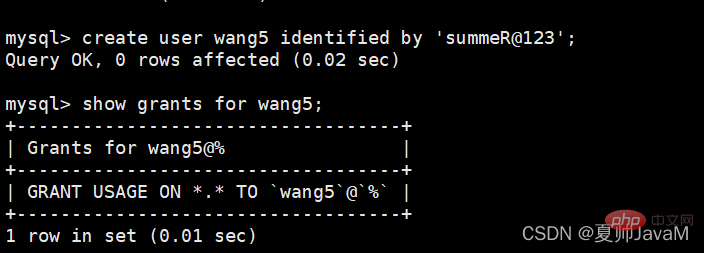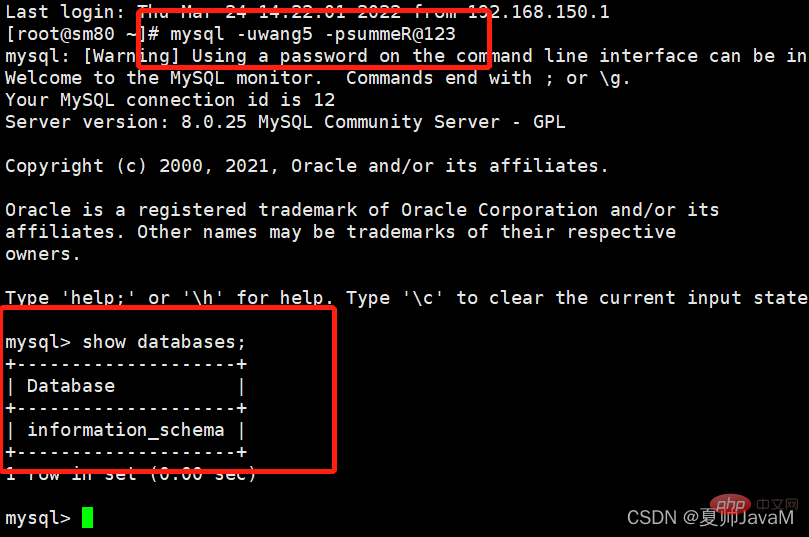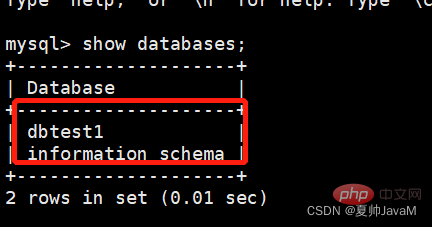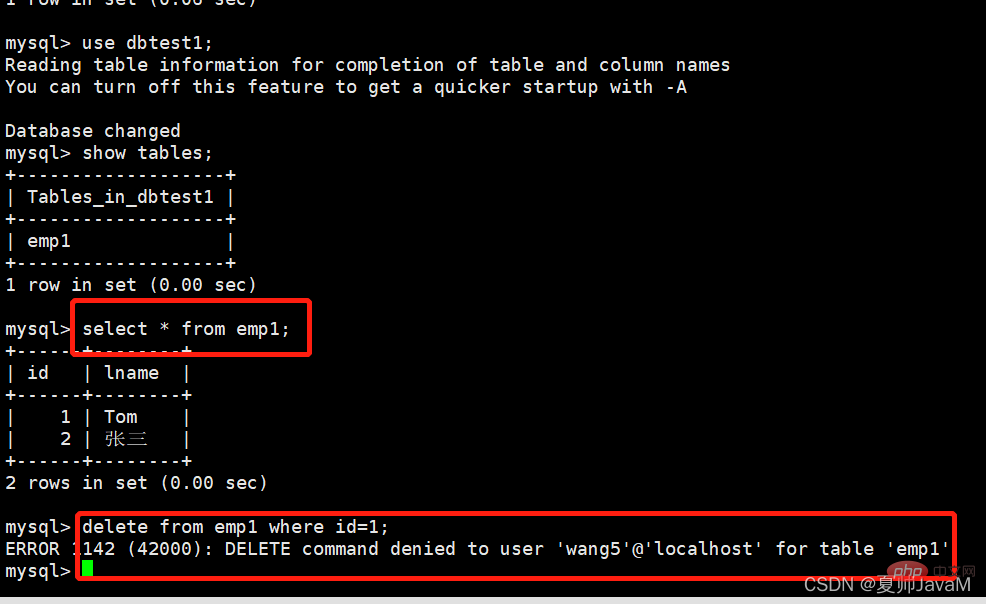Detailed explanation of examples of mysql database roles
This article brings you relevant knowledge about mysql, which mainly introduces the relevant content about database roles. You can grant permissions to users through roles to facilitate the management of users with the same permissions. Users, let’s take a look below, I hope it will be helpful to everyone.

Recommended learning: mysql video tutorial
Mysql database permissions management, simply give it to a certain user directly Add permissions. One troublesome thing about doing this is that when we have a lot of users, if these users all have the same permissions, the operation will be a bit redundant. Then we can grant permissions to users through roles.
Understanding of roles
The purpose of introducing roles is to facilitate the management of users with the same permissions. Appropriate permission settings can ensure data security, which is crucial

Create a role
Create a role using the CREATE ROLE statement, the syntax is as follows:
CREATE ROLE 'role_name'[@'host_name'] [,'role_name'[@'host_name']]...
Naming rules for role names Similar to username. If host_name is omitted, it defaults to %. role_name cannot be omitted and cannot be empty.
Exercise: Now we need to create a manager role, we can use the following code:
CREATE ROLE 'manager'@'localhost';
The effect is as shown below

Give permissions to the role
After creating a role, the default role is If there is no permission, we need to authorize the role. The syntax structure for granting role authorization is:
GRANT privileges ON table_name TO 'role_name'[@'host_name'];
Example: Grant the manager role permission to view all tables under the dbtest1 database

View role permissions

As long as you create a role, the system will automatically give you a "USAGE" permission, which means the permission to connect to the database
Reclaim the role's permissions
#After the role is authorized, you can maintain the role's permissions and add or revoke the permissions. Add permissions using the GRANT statement, which is the same as role authorization. To revoke a role or role permissions use the REVOKE statement.
Modifying the permissions of a role will affect the permissions of the account that owns the role.
The SQL syntax for revoking role permissions is as follows
REVOKE privileges ON tablename FROM 'rolename';
Now we add a delete permission to the manager, and then take back this permission

##Delete role
When we need to reintegrate the business Sometimes, you may need to clean up previously created roles and delete some roles that will no longer be used. The operation of deleting a character is very simple, you only need to master the grammatical structure.
DROP ROLE role [,role2]...
Note that if you delete a role, the user will lose all permissions obtained through this role.
给用户赋予角色
角色创建并授权后,要赋给用户并处于 激活状态 才能发挥作用。给用户添加角色可使用GRANT语句,语 法形式如下:
GRANT role [,role2,...] TO user [,user2,...];
在上述语句中,role代表角色,user代表用户。可将多个角色同时赋予多个用户,用逗号隔开即可。
例子:创建一个用户叫wang5 然后赋予角色manager,操作如下

用wang5登录并操作

赋予wang5角色manager 注意这个是通过root用户实现的

然后通过wang5登录查看数据库

此时还是看不到dbtest1,这是怎么回事呢?原来我们需要激活角色
激活角色
方式1:使用set default role 命令激活角色
SET DEFAULT ROLE ALL TO 'kangshifu'@'localhost';
现在激活manager角色

然后再通过wang5用户登录查看

激活方式2:将activate_all_roles_on_login设置为ON
默认情况:

设置 SET GLOBAL activate_all_roles_on_login=ON;
这条 SQL 语句的意思是,对 所有角色永久激活 。运行这条语句之后,用户才真正拥有了赋予角色的所有 权限。
那么现在wang5已经被赋予manager角色,我们知道manager角色只是有select的权限。我们做如下操作

撤销用户的角色
REVOKE role FROM user;
比如撤销 wang5的manager角色,通过root用户

再通过wang5登录看效果

推荐学习:mysql视频教程
The above is the detailed content of Detailed explanation of examples of mysql database roles. For more information, please follow other related articles on the PHP Chinese website!

Hot AI Tools

Undresser.AI Undress
AI-powered app for creating realistic nude photos

AI Clothes Remover
Online AI tool for removing clothes from photos.

Undress AI Tool
Undress images for free

Clothoff.io
AI clothes remover

Video Face Swap
Swap faces in any video effortlessly with our completely free AI face swap tool!

Hot Article

Hot Tools

Notepad++7.3.1
Easy-to-use and free code editor

SublimeText3 Chinese version
Chinese version, very easy to use

Zend Studio 13.0.1
Powerful PHP integrated development environment

Dreamweaver CS6
Visual web development tools

SublimeText3 Mac version
God-level code editing software (SublimeText3)

Hot Topics
 1387
1387
 52
52
 How to open phpmyadmin
Apr 10, 2025 pm 10:51 PM
How to open phpmyadmin
Apr 10, 2025 pm 10:51 PM
You can open phpMyAdmin through the following steps: 1. Log in to the website control panel; 2. Find and click the phpMyAdmin icon; 3. Enter MySQL credentials; 4. Click "Login".
 MySQL: An Introduction to the World's Most Popular Database
Apr 12, 2025 am 12:18 AM
MySQL: An Introduction to the World's Most Popular Database
Apr 12, 2025 am 12:18 AM
MySQL is an open source relational database management system, mainly used to store and retrieve data quickly and reliably. Its working principle includes client requests, query resolution, execution of queries and return results. Examples of usage include creating tables, inserting and querying data, and advanced features such as JOIN operations. Common errors involve SQL syntax, data types, and permissions, and optimization suggestions include the use of indexes, optimized queries, and partitioning of tables.
 How to use single threaded redis
Apr 10, 2025 pm 07:12 PM
How to use single threaded redis
Apr 10, 2025 pm 07:12 PM
Redis uses a single threaded architecture to provide high performance, simplicity, and consistency. It utilizes I/O multiplexing, event loops, non-blocking I/O, and shared memory to improve concurrency, but with limitations of concurrency limitations, single point of failure, and unsuitable for write-intensive workloads.
 MySQL's Place: Databases and Programming
Apr 13, 2025 am 12:18 AM
MySQL's Place: Databases and Programming
Apr 13, 2025 am 12:18 AM
MySQL's position in databases and programming is very important. It is an open source relational database management system that is widely used in various application scenarios. 1) MySQL provides efficient data storage, organization and retrieval functions, supporting Web, mobile and enterprise-level systems. 2) It uses a client-server architecture, supports multiple storage engines and index optimization. 3) Basic usages include creating tables and inserting data, and advanced usages involve multi-table JOINs and complex queries. 4) Frequently asked questions such as SQL syntax errors and performance issues can be debugged through the EXPLAIN command and slow query log. 5) Performance optimization methods include rational use of indexes, optimized query and use of caches. Best practices include using transactions and PreparedStatemen
 Why Use MySQL? Benefits and Advantages
Apr 12, 2025 am 12:17 AM
Why Use MySQL? Benefits and Advantages
Apr 12, 2025 am 12:17 AM
MySQL is chosen for its performance, reliability, ease of use, and community support. 1.MySQL provides efficient data storage and retrieval functions, supporting multiple data types and advanced query operations. 2. Adopt client-server architecture and multiple storage engines to support transaction and query optimization. 3. Easy to use, supports a variety of operating systems and programming languages. 4. Have strong community support and provide rich resources and solutions.
 Monitor Redis Droplet with Redis Exporter Service
Apr 10, 2025 pm 01:36 PM
Monitor Redis Droplet with Redis Exporter Service
Apr 10, 2025 pm 01:36 PM
Effective monitoring of Redis databases is critical to maintaining optimal performance, identifying potential bottlenecks, and ensuring overall system reliability. Redis Exporter Service is a powerful utility designed to monitor Redis databases using Prometheus. This tutorial will guide you through the complete setup and configuration of Redis Exporter Service, ensuring you seamlessly build monitoring solutions. By studying this tutorial, you will achieve fully operational monitoring settings
 How to view sql database error
Apr 10, 2025 pm 12:09 PM
How to view sql database error
Apr 10, 2025 pm 12:09 PM
The methods for viewing SQL database errors are: 1. View error messages directly; 2. Use SHOW ERRORS and SHOW WARNINGS commands; 3. Access the error log; 4. Use error codes to find the cause of the error; 5. Check the database connection and query syntax; 6. Use debugging tools.
 How to connect to the database of apache
Apr 13, 2025 pm 01:03 PM
How to connect to the database of apache
Apr 13, 2025 pm 01:03 PM
Apache connects to a database requires the following steps: Install the database driver. Configure the web.xml file to create a connection pool. Create a JDBC data source and specify the connection settings. Use the JDBC API to access the database from Java code, including getting connections, creating statements, binding parameters, executing queries or updates, and processing results.




